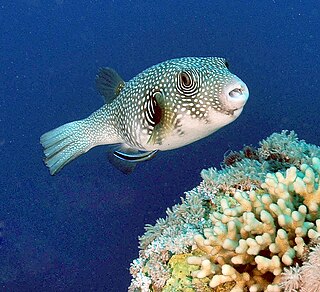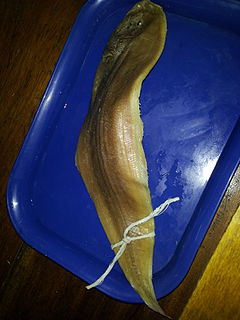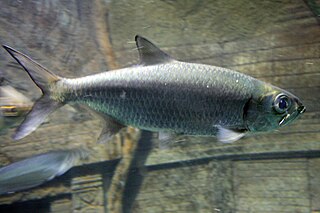Related Research Articles

The Indo-Pacific humpback dolphin is a species of humpback dolphin inhabiting coastal waters of the eastern Indian and western Pacific Oceans. This species is often referred to as the Chinese white dolphin in mainland China, Macao, Hong Kong, Taiwan and Singapore as a common name. Some biologists regard the Indo-Pacific dolphin as a subspecies of the Indian Ocean humpback dolphin which ranges from East Africa to India. However, DNA testing studies have shown that the two are distinct species. Additionally, a new species has just recently been split off from S. chinensis and recognized as a distinct species. Nevertheless, there are still several unresolved issues in differentiation of the Indian Ocean-type and Indo-Pacific-type humpback dolphins.

Haminoeidae, commonly known as the haminoeid bubble snail family, is a taxonomic family of sea snails, marine opisthobranch gastropod mollusks in the superfamily Haminoeoidea.

Atys is a genus of very small to medium-sized sea snails, marine opisthobranch gastropod mollusks in the family Haminoeidae.

Harpadon nehereus, called the Bombay duck, bummalo, bombil, and boomla is a species of lizardfish. Adults may reach a maximum length of 40 cm, but the usual size is around 25 cm.

The white-spotted puffer is a medium to large-sized puffer fish, it can reach 50 cm length. It is light grey in color, or greyish or yellowish, and clearly covered with more or less regular white points, that become concentric contrasting white and dark grey lines that radiate around the eyes and pectoral fins. The ventral part is white. The "shoulder" is dark. It also has concentric contrasting white and dark grey lines that radiate around the eyes and pectoral fins.

The Synodontidae or lizardfishes are benthic (bottom-dwelling) marine and estuarine bony fishes that belong to the aulopiform fish order, a diverse group of marine ray-finned fish consisting of some 15 extant and several prehistoric families. They are found in tropical and subtropical marine waters throughout the world.

Tonguefishes are flatfish in the family Cynoglossidae. They are distinguished by the presence of a long hook on the snout overhanging the mouth, and the absence of pectoral fins. Their eyes are both on the left side of their bodies, which also lack a pelvic fin. This family has three genera with a total of more than 140 species. The largest reaches a length of 66 cm (26 in), though most species only reach half that size or less. They are found in tropical and subtropical oceans, mainly in shallow waters and estuaries, though some species are found in deep sea floors, and even a few in rivers.

The Indo-Pacific tarpon, also known as the oxeye herring or simply herring, is a relatively medium-sized species of tarpon.

Ambassis is a genus of fish in the family Ambassidae, the Asiatic glassfishes. They are found widely in the Indo-Pacific region, with species in fresh, brackish and coastal marine waters.

The orange-spotted grouper, also known as the brown-spotted rockcod, estuary cod, estuary rockcod, goldspotted rockcod, greasy cod, North-west groper, orange spotted cod or blue-and-yellow grouper, is a species of marine ray-finned fish, a grouper from the subfamily Epinephelinae which is part of the family Serranidae, which also includes the anthias and sea basses. It has an Indo-Pacific distribution and is found in marine and brackish waters.

Xylocarpus is a genus of plants in the mahogany family (Meliaceae). It includes two or three species of mangroves, native to coastal mangrove forests of the Western and Central Indo-Pacific, from eastern Africa to Tonga.

Synanceia horrida, also known as the estuarine stonefish or regionally as simply stonefish, is a species of venomous fish of the family Synanceiidae. They are carnivorous ray-finned fish with venomous spines that lives on reef bottoms, camouflaged as a rock. They are one of the most venomous fish in the world, and are often included in private and public aquariums.
The speartoothed grinner(Synodus sageneus) is a species of lizardfish that lives mainly in the Indo-West Pacific.

Harpadon is a genus of bony fishes in the lizardfish family. The most famous member of this genus is the Bombay duck, H. nehereus, which is commercially fished to supply its use in Indian cuisine, especially in the area around Mumbai.

Haminoea is a genus of medium-sized sea snails or bubble snails, marine opisthobranch gastropod molluscs in the family Haminoeidae, the haminoea bubble snails, part of the clade Cephalaspidea, the headshield slugs and bubble snails.

The white sardinella, also known as deep-bodied sardine, perforated-scale sardine or short-bodied sardine, is a species of ray-finned fish in the genus Sardinella. It is an important food fish, which can be feed as dried, salted, or fresh forms.

The Indian mud moray eel, Gymnothorax tile is a moray eel found in the western Pacific and Indian Oceans. It was first named by Hamilton in 1822, and is also commonly known as the freshwater moray or freshwater snowflake eel.

Rhizophora mucronata is a species of mangrove found on coasts and river banks in East Africa and the Indo-Pacific region.

The rice-paddy eel is an eel in the family Ophichthidae. It was described by Francis Buchanan-Hamilton in 1822, originally in the genus Ophisurus. It is a tropical, marine eel which is known from the Indo-West Pacific, including Somalia, Tanzania, South Africa, southern India, Sri Lanka, Indonesia, Polynesia, Australia, Bangladesh, Cambodia, Kenya, Madagascar, the Philippines, Malaysia, Mozambique, Seychelles, Saudi Arabia, Taiwan, China, Thailand, Vietnam, and southern Yemen. It is an anadromous species and spawns in freshwater, often in rice paddies during the rainy season, earning it its common name. It also spends time in lagoons, estuaries and coastal rivers, in which it lives in burrows in the river bottom and bank. Males can reach a maximum total length (TL) of 100 centimetres, but more commonly reach a TL of 70 cm.
The diamond mullet, is a species of mullet and is also known as the Ord River mullet. This species lives in both brackish or freshwater. Adult fish are found in estuaries, coastal waters and in some cases, ascending rivers into fresh water.
References
- 1 2 Froese, Rainer and Pauly, Daniel, eds. (2014). "Harpadon translucens" in FishBase . October 2014 version.
- ↑ "Harpadon translucens — Overview Ghost Grinner". Encyclopedia of LIfe. Retrieved 13 June 2013.